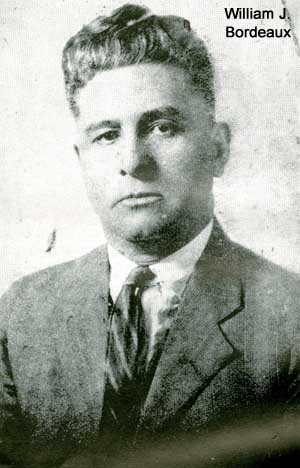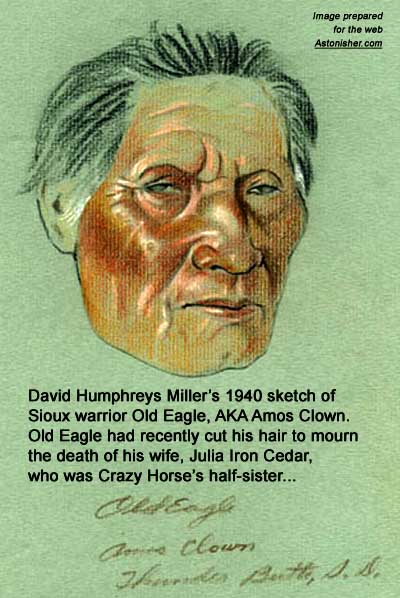|
||||||||||||
Bruce Brown's 100 Voices... William J. Bordeaux on Crazy Horse
THE CONQUEROR OF CUSTER
Hero of the Little Big Horn Since the discovery of the Red Man, most historians who have dwelt on Indian lore, have accepted their information from sources close to the military authorities and from Indian Agency Officials. While these reports are undoubtedly true as far as they go, they do not always represent the entire picture. In addition, glamourous chieftains have sometimes excited an interest in the public mind that was out of all proportion to their true worth. Of the many Sioux War-Chiefs who have achieved national recognition perhaps the one who has been most worthy of esteem has been the least considered of them all. The reasons for this are several. In the first place he was of a reserved nature and not given to a great show of affability even among the members of his own race, and secondly few white people ever encountered him; also he died at a time when general hostility between Whites and Indians had not entirely died out, and before reporting an interviewing had become a daily part of the life of outstanding personalities. The exact location of the birthplace of Crazy Horse has never been absolutely established and opinions differ. While some have declared that he was born near Laramie, Wyoming, others have believed that it was in the Dakota region. In view of this uncertainty, I interviewed several near relatives of the noted warrior including a full sister, Mrs. Clown. In my interview with her at her home, about seven miles East of the Thunder Butte Sub Station on the Cheyenne River Indian reservation, she told me, and her story has been substantiated by other relatives, that Crazy Horse was born somewhere near the mouth of the Laramie River in the southeastern part of Wyoming. As to the date of his birth both Mrs. Clown and her husband agreed that it was in the spring of the year that Left Hand Big Nose was killed by the Shonshonees. Tracing the years back on an Ogalala Wintercount and from the time of his death, I discovered that this would place his birth in 1839. Opinions have also differed as to the time of the occurrences of his surrender to the military authorities and of his escape from Red Cloud and of his subsequent return to Fort Robinson where he was killed by a military guard. In the pages that follow I have made an attempt to clear up some of the cloudiness that exists in connection with these events, but before proceeding further I will outline some of the incidents of his early life. The boyhood days of Crazy Horse were spent like those of other lads. No especial attributes distinguished him from other youths nor was he lauded for any particular feat until he had attained the age of seventeen. On that occasion as a member of an Ogalala war-party he was the third person to take part in the death of a Pawnee Indian in an encounter somewhere between the Platte and Republican Rivers. For this the youthful brave was lauded for his first coup (Toka-Kte) meaning killing the enemy or striking the foe. In our primitive tradition, blows that have been accomplished after the third one has taken place, are not considered worthy of mention and in this particular case the young brave just barely achieved an honor that entitled him to recognition. In 1863 at the age of 24 he [Crazy Horse] took part in the theft of 300 head of ponies from the Crow Tribe by a combined band of Ogalalas and Minnikanwojues. Three years later, in 1866, he was cited for unusual bravery at Fort Phil Kearney where 100 soldiers were killed by the Ogalalas in a fight known as the Fetterman massacre. According to tribal accounts, Crazy Horse rode out into the lead waving his tomahawk and, dashing among the troopers, he belabored them one after the other with deadly strokes. "He really was flirting with death" remarked one of the old warriors who took part in the battle. An open target for the rattled bluecoats he managed to evade almost certain destruction as he tore past them again and back to his own ranks through a curtaining rain of bullets. This daring show of bravery brought him tribal recognition and in addition to being called (Ohitika) brave and (Wakan) holy he was also regarded from that time on as of possible importance as a future leader. In 1867, following the Fort Phil Kearney battle, he became a member of a Sioux war-party that raided a wagon train on the Tongue River. Capturing the entire caravan the raiders discovered that the wagons were loaded mostly with blankets. On this occasion Crazy Horse selected a scarlet one for himself and wore it thereafter until the time of his death. The Treaty of 1868 Although Crazy Horse had by this time reached the stature of a leader among the members of his tribe, he decided to remain aloof from the council that was in progress at Fort Laramie, Wyoming, and I noticed that his mark X denoting signature was not to be found among the list of Sioux names on the historical document. Conspicuous for his careless manner towards public meetings, Crazy Horse was seldom known to attend one, and when he did so, he was extremely reserved and spoke only occasionally. The events that followed the signing of the historical treaty indicated that the Government was either not going to live up to its treaty-agreements or that it was going to do so only in an utterly lax and indecisive manner. No earnest attempt was made to close the Bozeman Trail and the covered wagons continued to pass through practically unrestrained. This and other regrettable infringements caused general uncertainty among t h e Sioux; but not so with Crazy Horse who had refused to become a party to what he termed False Papers. With the dissolution of the, council he and his mixed band of Brules, Ogalalas, Hunkpahpahs and Minnikanwojues headed north, and turning their backs on futility, followed the course of the Platte River toward the Big Horn Mountains. Custer's Conqueror by William J. Bordeaux, Smith & Company 1944 p 21 - 24
Born in 1884, William J. Bordeaux was the son of a white trader and a Brule Sioux mother, and a registered member of the Brule band of the Teton Sioux. He was not an eye-witness to the events he writes about, but like 100 Voices' other Indian chroniclers (Ohiyesa, John Stands In Timber, Bird Horse and Pretty Shield), Bordeaux had fluent, native access to some important participants whose information is not avialble elsewhere.
Furthermore, Bordeaux interviewed Crazy Horse's sister, Julia Iron Cedar or Mrs. Amos Clown, which makes his comments on Crazy Horse particularly important. For instance, Bordeaux records Crazy Horse's prediction that the Americans were lying and wouldn't honor the commitments they made to the Sioux in the treaty of 1868, which was true as it turned out. Improbably, William J. Bordeaux was also one of the most astute Indian observers of Crazy Horse's military innovations, describing how Crazy Horse very cleverly attacked a line of Custer's men head on and "slashed at them from both sides" at the Little Bighorn, thereby minimizing the Bluecoats' defensive firepower, and how at the Rosebud, he attacked Crook in encircling waves, a technique Crazy Horse developed to isolate and destroy portions of the American force piecemeal. See Sioux & Cheyenne Military Tactics during the American Wars of Imperial Conquest on the High Plains for more info. Similarly, Bordeaux's tantilizingly brief picture of Crazy Horse in action on the Powder River -- where he tersely yet wryly asks his sub-commanders, "how about it?" -- provides an almost Socratic picture of Crazy Horse in the commander's role. It isn't hard to imagine his eager young accolytes like Good Weasel and Kicking Bear and Little Big Man vying to provide the smartest -- effectively lethal -- answer to their mentor. -- Bruce Brown
|
||||||||||||




 IN MY attempts to discover facts in connection with the life of Crazy Horse I have only approached those people whom I deemed to be reliable, and in my capacity as a Federal Indian Interpreter for the U. S. District Attorney's Office and as a member of the Brule Sioux, I believe I have been able to obtain access to information that will throw additional light on the character of Crazy Horse which helps to show more effectively the part that he has played in the history of his times. Among those whom I intervied including my own rela-tives were some who had taken an actual part in some of the incidents that I have dealt with. My grandfather James Bordeaux was an early French fur trader among the Sioux and my grandmother was a full-blooded Sioux of the Minni-Kan-Wojo band. My father Louis Bordeaux was an interpreter for the Government in the early 70's and much of the information I have selected was taken from a collection of historical notes made by him during his lifetime. I believe that all the facts in this book are true and I have tried to avoid the inclusion of any material that might be considered doubtful.
IN MY attempts to discover facts in connection with the life of Crazy Horse I have only approached those people whom I deemed to be reliable, and in my capacity as a Federal Indian Interpreter for the U. S. District Attorney's Office and as a member of the Brule Sioux, I believe I have been able to obtain access to information that will throw additional light on the character of Crazy Horse which helps to show more effectively the part that he has played in the history of his times. Among those whom I intervied including my own rela-tives were some who had taken an actual part in some of the incidents that I have dealt with. My grandfather James Bordeaux was an early French fur trader among the Sioux and my grandmother was a full-blooded Sioux of the Minni-Kan-Wojo band. My father Louis Bordeaux was an interpreter for the Government in the early 70's and much of the information I have selected was taken from a collection of historical notes made by him during his lifetime. I believe that all the facts in this book are true and I have tried to avoid the inclusion of any material that might be considered doubtful.








